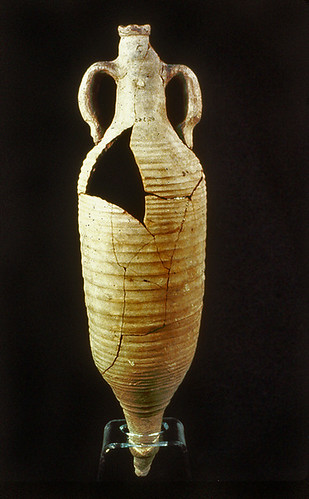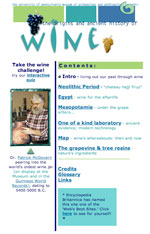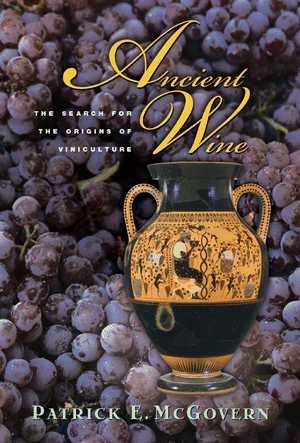Neolithic Wine!
A Momentous Innovation

Wine amphora from tomb 217 of cemetery 4 at Gebel Adda (Egypt), dated to early Byzantine times (the Ballana Period of Lower Nubia, 4th-early 6th c. AD). Photograph courtesy of W. Pratt and the Royal Ontario Museum (Egyptian Dept. no. 65:3:63).
The earliest chemically attested grape wine in the world was discovered by my laboratory at Hajji Firuz in the northwestern Zagros Mountains of Iran, ca. 5400 B.C. (Early Neolithic Period). Six jars of the same shape, each with a volume of about 9 liters, were found lined up and set into the floor of a “kitchen” in a square mudbrick Neolithic house, which are similar in construction and design to the Neolithic structures.
Analyses of the two jars in the Penn Museum showed that they had contained a resinated wine or “retsina,” i.e., with terebinth tree or pine resin added as a preservative and medical agent. There was a red to go with the white wine, based on the colors of the residues.
The history of civilization is, in many ways, the history of wine, and the earliest stages of vinicultural history and prehistory extend back into the Neolithic period and beyond. In my book on Ancient Wine, I take the reader on a personal odyssey back to the beginnings of this consequential beverage when early humans probably enjoyed a wild grape wine. I follow the course of human ingenuity in domesticating the Eurasian vine and learning how to make and preserve wine some 7,000 years ago.
Early winemakers must have marveled at the seemingly miraculous process of fermentation. From success to success, viniculture stretched out its tentacles and entwined itself with one culture after another (whether Egyptian, Iranian, Israelite, or Greek) and laid the foundation for civilization itself. As medicine, social lubricant, mind-altering substance, and highly valued commodity, wine became the focus of religious cults, pharmacopoeias, cuisines, economies, and society. As an evocative symbol of blood, it was used in temple ceremonies and occupies the heart of the Eucharist. Kings celebrated their victories with wine and made certain that they had plenty for the afterlife. Some peoples truly became “wine cultures.” When we sip a glass of wine today, we recapitulate this dynamic history in which a single grape species was harnessed to yield an almost infinite range of tastes and bouquets.
I am currently collaborating on DNA sequencing of ancient yeast and grape with laboratories in Italy, Switzerland, Spain, and the U.S. The earliest preserved wine/bread/beer yeast (ca. 3150 B.C.) was identified at Abydos in Egypt (see Research on Egyptian Medicinal Wine), and modern Middle Eastern grape varietals from the Caucasus and eastern Turkey, crucial to determining where the Eurasian grapevine was first domesticated, were sequenced. It appears very likely that the wild Eurasian grapevine, Vitis vinifera sylvestris, was taken into domestication somewhere in the arc of mountains extending from the eastern Taurus across Transcaucasia to the northwestern Zagros.
Analyses of unique chlorite bowls and goblets from spectacular early Neolithic sites in eastern Turkey and very early pottery from Georgia are being carried out in collaboration with the U.S. Government Tax and Trade Commission Laboratory (Beltsville, MD). These areas were likely “hotbeds” of experimentation in the Neolithic period. DNA evidence supports the domestication of one of the Neolithic “founder plants”–einkorn wheat–in eastern Turkey, and chickpea and bitter vetch are also traced to this area, so why not the grapevine?
The upland areas of the Caucasus, Taurus, and Zagros Mountains are all possibilities for the earliest domestication and the beginning of winemaking. What especially makes me think that the origins of viniculture may be found here is that there is a great deal of archaeological and historical evidence for what can be called a “wine culture” gradually radiating out in time and space, from small beginnings in the northern mountains of the Near East in the Neolithic, to become a dominant economic, religious and social force throughout the region and later across Europe in the millennia to follow.
A new collaboration with the Helmholtz Zentrum München and the Institut Universitaire de la Vigne et du Vin-Jules Guyot in Dijon, using Fourier transform ion cyclotron resonance mass spectrometry, strongly supports the presence of reservatrol in an ancient wine sample. This compound is known to extend mammalian life expectancy.
I am now engaged in a new project at Lattes in southern France with Benjamin Luley and Michael Dietler of the University of Chicago, which has as its goal tracing the transfer of the “wine culture” to this area from ca. 600 B.C. onwards by the Phoenicians, Greeks, and/or Etruscans. In the centuries to follow, as viniculture spread to the rest of France, the implications for world winemaking and its culture were enormous.
I am also involved in analyzing and publishing archaeological materials from Ashkelon and two 8th c. B.C. Phoenician shipwrecks off the coast. I have carried out Neutron Activation Analysis of 60 pottery sherds from Ashkelon (bowls, jugs, amphoras, cooking pots, probable Chocolate-on-White ware, and Levantine Painted pottery) and Egyptianizing sealings of the enigmatic Middle Bronze IIA period, which are not yet published. The results will show that Ashkelon is the major trading partner with Tell el-Dab`a in the Nile Delta and most likely where the Hyksos originated (see my book, The Foreign Relations of the “Hyksos”: A Neutron Activation Study of Middle Bronze Age Pottery from the Eastern Mediterranean, Archaeopress, Oxford, 2000). Overwhelmingly, the pottery and sealings at Ashkelon were made locally; only a few sherds were imported from the Nile Delta and Cilicia.
My laboratory has identified and published the finding of resinated wine inside a Phoenician amphora in one of the 8th c. B.C. shipwrecks. From Ashkelon proper, we are testing residues from a probable Iron IA winepress and from enigmatic underground jars and other installations of late Iron Age date that might have been used to make “grappa” or for dyeing.
 Fermented beverages have been preferred over water throughout the ages: they are safer, provide psychotropic effects, and are more nutritious. Some have even said alcohol was the primary agent for the development of Western civilization, since more healthy individuals (even if inebriated much of the time) lived longer and had greater reproductive success. This website introduces you to ancient wine-making practices in the Neolithic period, in ancient Egypt, and Mesopotamia. Visit the Origins and Ancient History of Wine website.
Fermented beverages have been preferred over water throughout the ages: they are safer, provide psychotropic effects, and are more nutritious. Some have even said alcohol was the primary agent for the development of Western civilization, since more healthy individuals (even if inebriated much of the time) lived longer and had greater reproductive success. This website introduces you to ancient wine-making practices in the Neolithic period, in ancient Egypt, and Mesopotamia. Visit the Origins and Ancient History of Wine website.
 Ancient Wine: The Search for the Origins of Viniculture
Ancient Wine: The Search for the Origins of Viniculture
by Dr. Patrick E. McGovern (Princeton University Press)
This book is the first comprehensive and up-to-date account of the earliest stages of vinicultural history and prehistory, which extends back into the Neolithic period and beyond. Elegantly written and richly illustrated, Ancient Wine opens up whole new chapters in the fascinating story of wine and the vine by drawing upon recent archaeological discoveries, molecular and DNA sleuthing, and the texts and art of long-forgotten peoples.
Resources
P. E. McGovern, U. Hartung, V. R. Badler, D. L. Glusker, and L. J. Exner
The Beginnings of Winemaking and Viniculture in the Ancient Near East and Egypt. Expedition 39/1: 3-21. 1997
P. E. McGovern, M. M. Voigt, D. L. Glusker, and L. J. Exner
Neolithic Resinated Wine. Nature 381 (June 6): 480-81. 1996
Genetic characterization and relationships of traditional grape cultivars from Transcaucasia and Anatolia. Molecular Ecology 15: 3707-14 (with R. Arroyo-Garcia, et al.) 2006
Genetic characterization and relationships of traditional grape cultivars from Transcaucasia and Anatolia. Plant Genetic Resources: Characterization & Utilization, 4.2: 144-58 (with J. F. Vouillamoz, A. Ergul, G. Söylemezo—lu, G. Tevzadze, and M. S. Grando). 2006
Evidence for S. cerevisiae Fermentation in Ancient Wine. Journal of Molecular Evolution 57: S226-232 (with D. Cavalieri, D. L. Hartl, R. Mortimer, and M. Polsinelli). 2003
